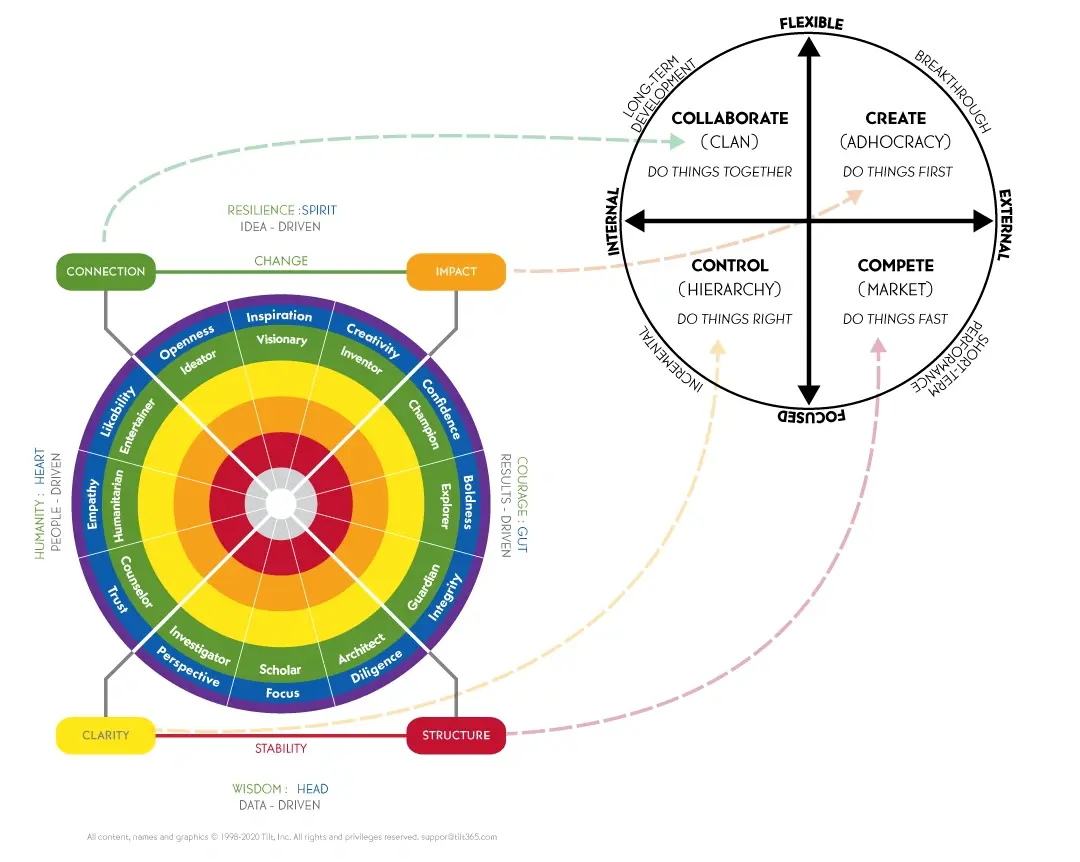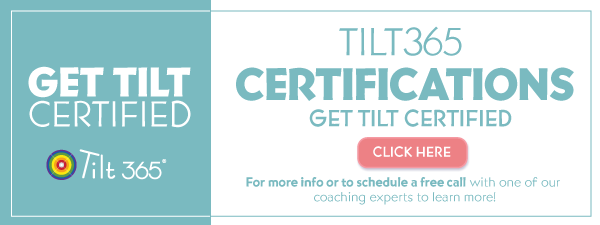

Changing organizational cultures is well known to be an arduous process. To alter an organization's identity with time-held traditions requires aligning and shifting the mindsets and behaviors of large numbers of people, which is a challenging task. To help with these large-scale transformations, frameworks of identity patterns and character traits are extremely useful. One highly cited framework used for culture change is the Competing Values Framework (CVF) by Cameron & Quinn (2011), which lists four dominant organizational cultures: Adhocracy, Hierarchy, Clan, and Market.
Similar to the four dominant cultures of the CVF, the Tilt Framework contains four dominant personality patterns. Yet, unlike the four cultures of the CVF, leaders can apply the four Tilt patterns beyond just organizational culture. Leaders and facilitators can also use them to help people understand themselves, others, and even system dynamics. By aligning a variety of deeper dimensions, including sub-personas and character strengths, the Tilt Framework is designed to be actionable on all levels, and for much more than just culture change. As such, the four dominant Tilt patterns of the Tilt Framework are Impact, Clarity, Connection, and Structure.
Aligning the Frameworks
The Tilt Framework and Competing Values Framework (CVF) both use axes to describe polarities of priorities and preferences. In brief, the x-axis of the CVF is based on an organization’s tendency of prioritizing internal operations and employees (incremental change, long-term development) or a tendency of prioritizing external customer relations and market share (short-term performance, innovations). The y-axis of the CVF is based on how flexible or focused an organization’s approach to operations and processes are, whether intentional or unintentional.
In comparison, the x-axis of the Tilt Framework is based on the prioritization level between people/relationships and achieving results (humanity←→courage). The y-axis of the Tilt Framework is based on the preferences of thinking style, in terms of being driven by visionary ideas or intricate data (resilience←→wisdom).
In both frameworks, the left side of the x-axis–people-driven and internal-priority–relate, as they both emphasize understanding, connection, and empathy towards coworkers. The right side of the x-axis of both frameworks–results-driven and external-priority–relate, as they share a common emphasis on outcomes and interactions beyond the immediate work environment.
In both frameworks, the top of the y-axis–visionary-ideas and flexible-approach) relate, as both represent a choice between embracing change, innovation, and dynamic thinking. In both frameworks, the bottom of the y-axis–intricate-data and focused-approach) relate, as both value structure, predictability, and reliance on factual information.
Overall, while the terminology and specific dimensions of these frameworks differ, they share underlying concepts related to how people navigate competing polarities in their decision-making and work style. Additionally, both frameworks recognize the need to balance these polarities (becoming agile) to achieve optimal outcomes (generativity) in complex and dynamic work environments.
Comparing the Quadrants
With the x and y-axes of the two frameworks being polarities of contrasting characteristics, each of the four quadrants within the frameworks are also in opposition to the quadrant that is directly across from it. With Impact/Adhocracy←→Clarity/Hierarchy and Connection/Clan←→Structure/Market being in opposition to each other.
Impact Tilt & Adhocracy Culture
The Impact Tilt pattern and Adhocracy culture are both located in the upper right quadrant of the framework (results/ideas–external/flexible). Adhocracy in the CVF represents a culture characterized by innovation and risk-taking. Organizations with an adhocracy culture value adaptability and experimentation. The Impact pattern in the Tilt Framework is similar as both emphasize change and innovation. People, teams, and organizations with a dominant Impact pattern prioritize creating positive and transformative changes in their environments.
Clarity Tilt & Hierarchy Culture
Opposite the Impact pattern and Adhocracy culture, the Clarity Tilt pattern and Hierarchy culture are both located in the lower left quadrant of the frameworks (people/data–internal/stable). In direct contrast to Adhocracy culture, Hierarchy culture in the CVF is characterized by a structured and controlled environment where rules and processes are essential. It values stability and control. Similarly, Clarity in the Tilt Framework, is related in the sense that both emphasize clear operating procedures. People, teams, and organizations with a dominant Clarity pattern prioritize well-defined roles, responsibilities, and processes to achieve their goals.
Connection Tilt & Clan Culture
The Connection Tilt pattern and Clan culture are both located in the upper left quadrant of the frameworks (people/ideas–internal/flexible). Clan culture in the CVF emphasizes a family-like atmosphere within an organization. It values teamwork, collaboration, and employee engagement. Connection in the Tilt Framework relates to building strong relationships, fostering trust, and emphasizing interpersonal connections. People, teams, and organizations with dominant Connection patterns prioritize people and relationships within organizations.
Structure Tilt & Market Culture
Opposite the Connection pattern and Clan culture, the Structure Tilt pattern and Market culture are both located in the lower right quadrant of the frameworks (results/data–external/stable). In direct contrast to Clan culture, Market culture in the CVF focuses on competition, results, and achievement. It values market share and profitability. Similarly, Structure in the Tilt Framework, is related in the sense that both emphasize achieving results and setting clear goals. People, teams, and organizations with a dominant Structure pattern prioritize efficiency and are driven to achieve measurable outcomes.
Summary
While the Tilt Framework and Competing Values Framework have different terminology and applications, there are connections and similarities between their respective dimensions and characteristics. Impact and Adhocracy both emphasize innovation and change, Clarity and Hierarchy value processes and control, Connection and Clan prioritize people and relationships, and Structure and Market focus on achieving results and goals. However, unlike the CVF, the Tilt Framework can be applied beyond organization cultures, to include team climates and individual personalities–macro, mezzo, and micro levels. Furthermore, the Tilt Framework and assessments are designed to help individuals, teams, and organizations become agile in their ability to shift between the four patterns–Intentional Tilting–based on changing work contexts to achieve generativity. This way, by leveraging Tilt’s personality assessments, leaders can better understand and harness the underlying dimensions of their organization’s people-dynamics (at all levels) to drive more effective performance and achievement.
Stay tuned for next week’s post where I’ll discuss how targeting team climates is the key to culture change!



